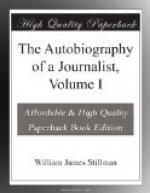His adoration of his wife was fully justified, for rarely have I seen a woman in whom a Juno-like dignity and serenity were so wedded to personal beauty and to the fine culture of brain and heart, which commanded reverence from the most ordinary acquaintance, as in her. No one who had seen her at home could ever forget the splendid vision, and the last time I ever saw her, so far as I remember, was in summer time, when she and her two daughters, all in white muslin, like creatures of another world, evanescent, translucent, stood in the doorway to say good-by to me. In the same costume, a little later, she met death. She was making impressions in sealing-wax, to amuse her daughters, when a flaming drop fell on the inflammable stuff, and in an instant she was in flames, burned to death before help could come. It was then that they found that Longfellow was not the cold man they had generally believed him. He never recovered from the bereavement, and shortly after he became a Spiritualist, and, until he in his glad turn passed the gates of death, he lived in what he knew to be the light of her presence. And certainly if such a thing as communion across that grim threshold can be, this was the occasion which made it possible. There was something angelic about them both, even in this life,—a natural innocence and large beneficence and equanimity which, in the chance and contradiction of life, could rarely be found in wedded state.
One of the most notable personages of that little world, whom I knew in connection with Longfellow, was his brother-in-law,—Thomas G. Appleton,—a most distinguished amateur of art; a subtle, if sometimes vagarious, critic, poet, and thinker: the wit to whom most of the clever things said in Boston came naturally in time to be attributed. The famous saying that “Good Americans, when they die, go to Paris,” is generally supposed to be his, though Oliver Wendell Holmes told me one day that he himself was really the author of it; but, if a keen witticism was floating about fatherless in the Boston circles it drifted to Tom Appleton as putative parent. His, too, was a kindly nature, and many a rising artist found his way to a larger recognition by Appleton’s unobtrusive aid. He, like Longfellow, was a sincere Spiritualist. One of the most remarkable of this group of men was Professor Peirce, mathematician, of whose flights into the higher regions of the science of numbers and quantities many interesting things were told. He had written a book to show, if I remember right after so many years, that the square root of minus one was a right angle
__
(\/-1=90 deg.),
which was said to have been read only by a mathematician who presided over an observatory in the Ural Mountains. He had an extraordinary power of making his abstruse results clear to the ordinary intellect, and was in various directions a brilliant conversationalist. One day, going into Boston in the omnibus with him, I questioned him as to the famous problem. To my astonishment he went through a demonstration adapted to my intelligence which made me understand the nature of the substitution and the solution before our half hour’s transit was ended. I did not understand the mathematical statement, but he put it in common-sense terms, which I apprehended perfectly, though I never could repeat them.




